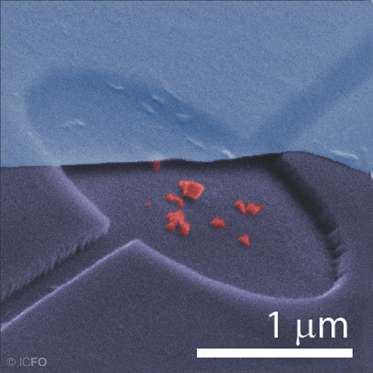Controlling on-chip nano-optics by graphene nano-opto-mechanics

Active in situ control of light at the nanoscale remains a challenge in modern physics and in nanophotonics in particular. A promising approach is to take advantage of the technological maturity of nanoelectromechanical systems (NEMS) and combine the technology with on-chip optics, but the integration of such small devices with optical fields remains difficult.
In a recent work published in Nature Communications, ICFO researchers Dr. Antoine Reserbat-Plantey, Kevin G. Schadler, and Dr. Louis Gaudreau, led by ICREA Professors at ICFO Frank H. L. Koppens and Adrian Bachtold and ICFO Professor Darrick Chang, have presented a novel type of hybrid system consisting of an on-chip graphene NEMS suspended a few tens of nanometres above nitrogen-vacancy centres (NVCs), which are stable, single-photon emitters embedded in nanodiamonds. Their work has confirmed that graphene is an ideal platform for both nanophotonics and nanomechanics.
For their study, the researchers fabricated such an original hybrid device for the first time. Due to its electromechanical properties, graphene NEMS can be actuated and deflected electrostatically over few tens of nanometres with modest voltages applied to a gate electrode. The graphene motion can thus be used to modulate the light emission by the NVC, while the emitted field can be used as a universal probe of the graphene position. The optomechanical coupling between the graphene displacement and the NVC emission is based on near-field dipole-dipole interactions.
The researchers could see that the coupling strength increases strongly for shorter distances and is enhanced because of graphene's two-dimensional (2D) character and linear dispersion. These achievements hold promise for selective control of emitter arrays on-chip, optical spectroscopy of individual nano-objects, integrated optomechanical information processing, and opens new avenues toward quantum optomechanics.
More information: Antoine Reserbat-Plantey et al. Electromechanical control of nitrogen-vacancy defect emission using graphene NEMS, Nature Communications (2016). DOI: 10.1038/ncomms10218
Journal information: Nature Communications
Provided by The Institute of Photonic Sciences



















